Legal Analysis: Negligence, Duty of Care, and Damages in a Supermarket
VerifiedAdded on 2023/06/05
|5
|1419
|116
Case Study
AI Summary
This case study analyzes a negligence claim where Tamara sustained injuries at an Aldi supermarket due to a slippery floor caused by melted ice cream. The analysis explores the legal principles of duty of care, breach, and causation, referencing key cases like Donoghue v Stevenson. It assesses whether Aldi breached its duty of care to Tamara and if this breach directly led to her injuries and subsequent damages. The study also considers the potential defense of contributory negligence, examining whether Tamara's actions contributed to her fall. The conclusion suggests that while Aldi may be liable for negligence, the supermarket could potentially reduce its liability proportionally by successfully arguing contributory negligence on Tamara's part. Desklib provides a platform to access this and many other solved assignments for students.
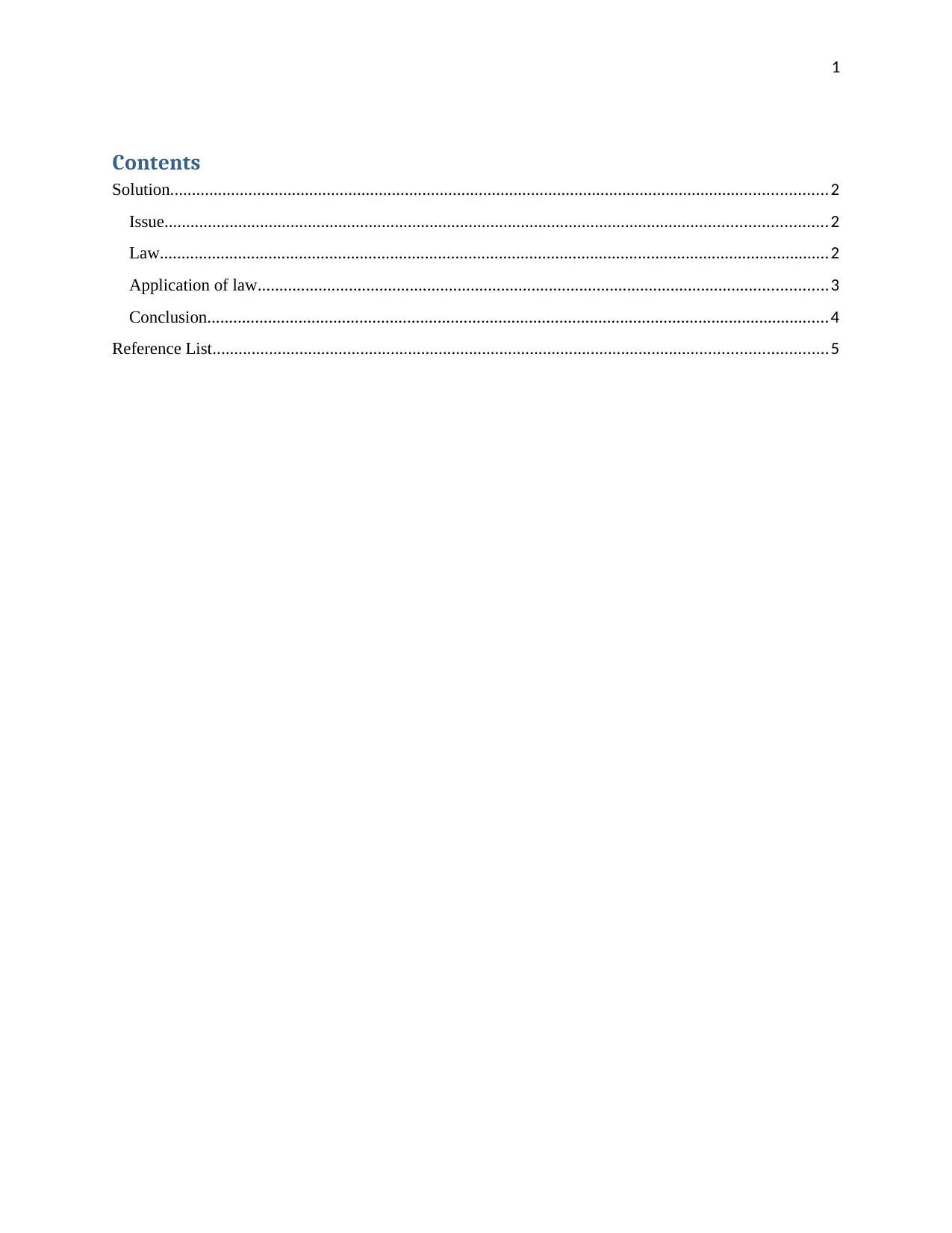
1
Contents
Solution.......................................................................................................................................................2
Issue........................................................................................................................................................2
Law..........................................................................................................................................................2
Application of law...................................................................................................................................3
Conclusion...............................................................................................................................................4
Reference List.............................................................................................................................................5
Contents
Solution.......................................................................................................................................................2
Issue........................................................................................................................................................2
Law..........................................................................................................................................................2
Application of law...................................................................................................................................3
Conclusion...............................................................................................................................................4
Reference List.............................................................................................................................................5
Paraphrase This Document
Need a fresh take? Get an instant paraphrase of this document with our AI Paraphraser
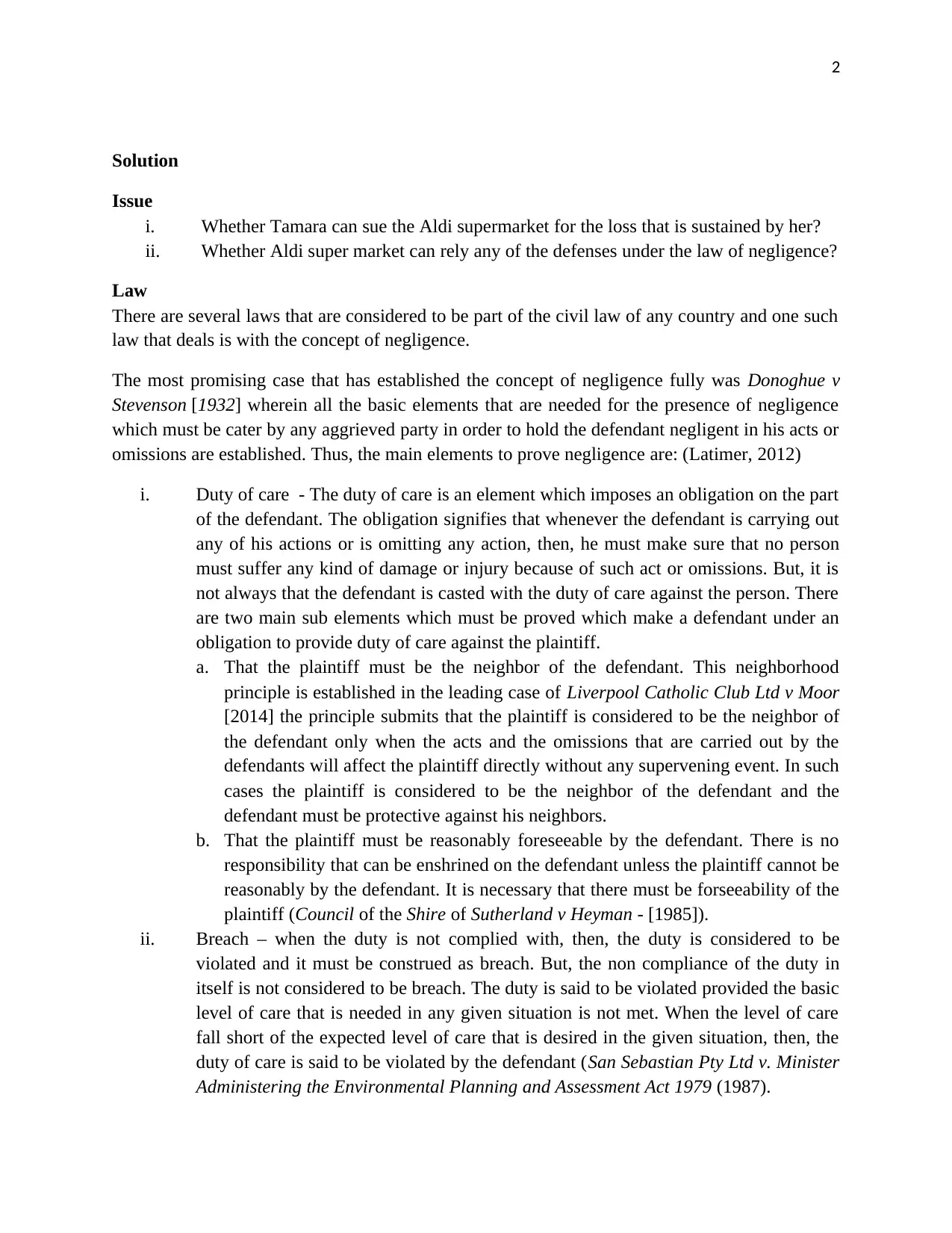
2
Solution
Issue
i. Whether Tamara can sue the Aldi supermarket for the loss that is sustained by her?
ii. Whether Aldi super market can rely any of the defenses under the law of negligence?
Law
There are several laws that are considered to be part of the civil law of any country and one such
law that deals is with the concept of negligence.
The most promising case that has established the concept of negligence fully was Donoghue v
Stevenson [1932] wherein all the basic elements that are needed for the presence of negligence
which must be cater by any aggrieved party in order to hold the defendant negligent in his acts or
omissions are established. Thus, the main elements to prove negligence are: (Latimer, 2012)
i. Duty of care - The duty of care is an element which imposes an obligation on the part
of the defendant. The obligation signifies that whenever the defendant is carrying out
any of his actions or is omitting any action, then, he must make sure that no person
must suffer any kind of damage or injury because of such act or omissions. But, it is
not always that the defendant is casted with the duty of care against the person. There
are two main sub elements which must be proved which make a defendant under an
obligation to provide duty of care against the plaintiff.
a. That the plaintiff must be the neighbor of the defendant. This neighborhood
principle is established in the leading case of Liverpool Catholic Club Ltd v Moor
[2014] the principle submits that the plaintiff is considered to be the neighbor of
the defendant only when the acts and the omissions that are carried out by the
defendants will affect the plaintiff directly without any supervening event. In such
cases the plaintiff is considered to be the neighbor of the defendant and the
defendant must be protective against his neighbors.
b. That the plaintiff must be reasonably foreseeable by the defendant. There is no
responsibility that can be enshrined on the defendant unless the plaintiff cannot be
reasonably by the defendant. It is necessary that there must be forseeability of the
plaintiff (Council of the Shire of Sutherland v Heyman - [1985]).
ii. Breach – when the duty is not complied with, then, the duty is considered to be
violated and it must be construed as breach. But, the non compliance of the duty in
itself is not considered to be breach. The duty is said to be violated provided the basic
level of care that is needed in any given situation is not met. When the level of care
fall short of the expected level of care that is desired in the given situation, then, the
duty of care is said to be violated by the defendant (San Sebastian Pty Ltd v. Minister
Administering the Environmental Planning and Assessment Act 1979 (1987).
Solution
Issue
i. Whether Tamara can sue the Aldi supermarket for the loss that is sustained by her?
ii. Whether Aldi super market can rely any of the defenses under the law of negligence?
Law
There are several laws that are considered to be part of the civil law of any country and one such
law that deals is with the concept of negligence.
The most promising case that has established the concept of negligence fully was Donoghue v
Stevenson [1932] wherein all the basic elements that are needed for the presence of negligence
which must be cater by any aggrieved party in order to hold the defendant negligent in his acts or
omissions are established. Thus, the main elements to prove negligence are: (Latimer, 2012)
i. Duty of care - The duty of care is an element which imposes an obligation on the part
of the defendant. The obligation signifies that whenever the defendant is carrying out
any of his actions or is omitting any action, then, he must make sure that no person
must suffer any kind of damage or injury because of such act or omissions. But, it is
not always that the defendant is casted with the duty of care against the person. There
are two main sub elements which must be proved which make a defendant under an
obligation to provide duty of care against the plaintiff.
a. That the plaintiff must be the neighbor of the defendant. This neighborhood
principle is established in the leading case of Liverpool Catholic Club Ltd v Moor
[2014] the principle submits that the plaintiff is considered to be the neighbor of
the defendant only when the acts and the omissions that are carried out by the
defendants will affect the plaintiff directly without any supervening event. In such
cases the plaintiff is considered to be the neighbor of the defendant and the
defendant must be protective against his neighbors.
b. That the plaintiff must be reasonably foreseeable by the defendant. There is no
responsibility that can be enshrined on the defendant unless the plaintiff cannot be
reasonably by the defendant. It is necessary that there must be forseeability of the
plaintiff (Council of the Shire of Sutherland v Heyman - [1985]).
ii. Breach – when the duty is not complied with, then, the duty is considered to be
violated and it must be construed as breach. But, the non compliance of the duty in
itself is not considered to be breach. The duty is said to be violated provided the basic
level of care that is needed in any given situation is not met. When the level of care
fall short of the expected level of care that is desired in the given situation, then, the
duty of care is said to be violated by the defendant (San Sebastian Pty Ltd v. Minister
Administering the Environmental Planning and Assessment Act 1979 (1987).
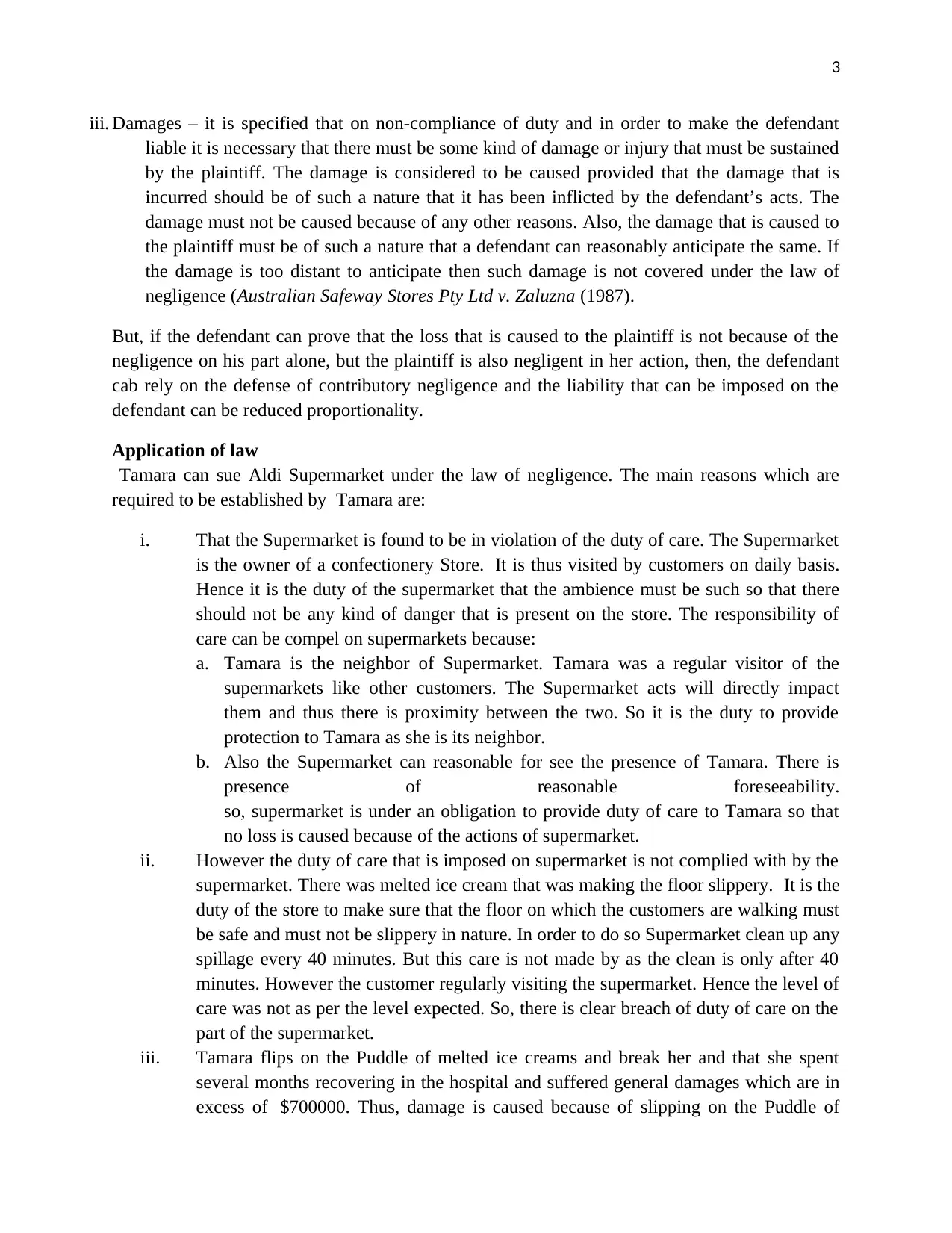
3
iii. Damages – it is specified that on non-compliance of duty and in order to make the defendant
liable it is necessary that there must be some kind of damage or injury that must be sustained
by the plaintiff. The damage is considered to be caused provided that the damage that is
incurred should be of such a nature that it has been inflicted by the defendant’s acts. The
damage must not be caused because of any other reasons. Also, the damage that is caused to
the plaintiff must be of such a nature that a defendant can reasonably anticipate the same. If
the damage is too distant to anticipate then such damage is not covered under the law of
negligence (Australian Safeway Stores Pty Ltd v. Zaluzna (1987).
But, if the defendant can prove that the loss that is caused to the plaintiff is not because of the
negligence on his part alone, but the plaintiff is also negligent in her action, then, the defendant
cab rely on the defense of contributory negligence and the liability that can be imposed on the
defendant can be reduced proportionality.
Application of law
Tamara can sue Aldi Supermarket under the law of negligence. The main reasons which are
required to be established by Tamara are:
i. That the Supermarket is found to be in violation of the duty of care. The Supermarket
is the owner of a confectionery Store. It is thus visited by customers on daily basis.
Hence it is the duty of the supermarket that the ambience must be such so that there
should not be any kind of danger that is present on the store. The responsibility of
care can be compel on supermarkets because:
a. Tamara is the neighbor of Supermarket. Tamara was a regular visitor of the
supermarkets like other customers. The Supermarket acts will directly impact
them and thus there is proximity between the two. So it is the duty to provide
protection to Tamara as she is its neighbor.
b. Also the Supermarket can reasonable for see the presence of Tamara. There is
presence of reasonable foreseeability.
so, supermarket is under an obligation to provide duty of care to Tamara so that
no loss is caused because of the actions of supermarket.
ii. However the duty of care that is imposed on supermarket is not complied with by the
supermarket. There was melted ice cream that was making the floor slippery. It is the
duty of the store to make sure that the floor on which the customers are walking must
be safe and must not be slippery in nature. In order to do so Supermarket clean up any
spillage every 40 minutes. But this care is not made by as the clean is only after 40
minutes. However the customer regularly visiting the supermarket. Hence the level of
care was not as per the level expected. So, there is clear breach of duty of care on the
part of the supermarket.
iii. Tamara flips on the Puddle of melted ice creams and break her and that she spent
several months recovering in the hospital and suffered general damages which are in
excess of $700000. Thus, damage is caused because of slipping on the Puddle of
iii. Damages – it is specified that on non-compliance of duty and in order to make the defendant
liable it is necessary that there must be some kind of damage or injury that must be sustained
by the plaintiff. The damage is considered to be caused provided that the damage that is
incurred should be of such a nature that it has been inflicted by the defendant’s acts. The
damage must not be caused because of any other reasons. Also, the damage that is caused to
the plaintiff must be of such a nature that a defendant can reasonably anticipate the same. If
the damage is too distant to anticipate then such damage is not covered under the law of
negligence (Australian Safeway Stores Pty Ltd v. Zaluzna (1987).
But, if the defendant can prove that the loss that is caused to the plaintiff is not because of the
negligence on his part alone, but the plaintiff is also negligent in her action, then, the defendant
cab rely on the defense of contributory negligence and the liability that can be imposed on the
defendant can be reduced proportionality.
Application of law
Tamara can sue Aldi Supermarket under the law of negligence. The main reasons which are
required to be established by Tamara are:
i. That the Supermarket is found to be in violation of the duty of care. The Supermarket
is the owner of a confectionery Store. It is thus visited by customers on daily basis.
Hence it is the duty of the supermarket that the ambience must be such so that there
should not be any kind of danger that is present on the store. The responsibility of
care can be compel on supermarkets because:
a. Tamara is the neighbor of Supermarket. Tamara was a regular visitor of the
supermarkets like other customers. The Supermarket acts will directly impact
them and thus there is proximity between the two. So it is the duty to provide
protection to Tamara as she is its neighbor.
b. Also the Supermarket can reasonable for see the presence of Tamara. There is
presence of reasonable foreseeability.
so, supermarket is under an obligation to provide duty of care to Tamara so that
no loss is caused because of the actions of supermarket.
ii. However the duty of care that is imposed on supermarket is not complied with by the
supermarket. There was melted ice cream that was making the floor slippery. It is the
duty of the store to make sure that the floor on which the customers are walking must
be safe and must not be slippery in nature. In order to do so Supermarket clean up any
spillage every 40 minutes. But this care is not made by as the clean is only after 40
minutes. However the customer regularly visiting the supermarket. Hence the level of
care was not as per the level expected. So, there is clear breach of duty of care on the
part of the supermarket.
iii. Tamara flips on the Puddle of melted ice creams and break her and that she spent
several months recovering in the hospital and suffered general damages which are in
excess of $700000. Thus, damage is caused because of slipping on the Puddle of
⊘ This is a preview!⊘
Do you want full access?
Subscribe today to unlock all pages.

Trusted by 1+ million students worldwide
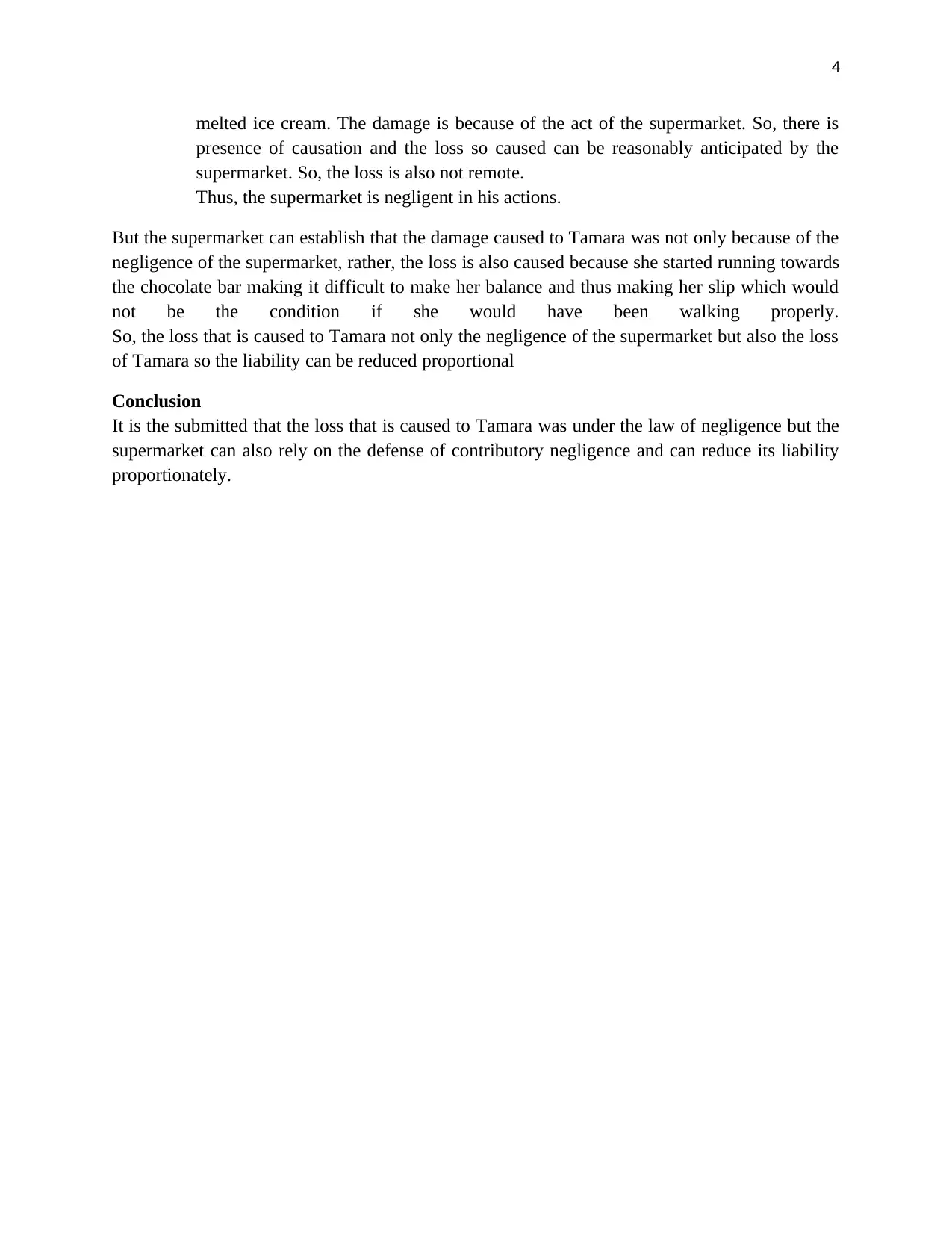
4
melted ice cream. The damage is because of the act of the supermarket. So, there is
presence of causation and the loss so caused can be reasonably anticipated by the
supermarket. So, the loss is also not remote.
Thus, the supermarket is negligent in his actions.
But the supermarket can establish that the damage caused to Tamara was not only because of the
negligence of the supermarket, rather, the loss is also caused because she started running towards
the chocolate bar making it difficult to make her balance and thus making her slip which would
not be the condition if she would have been walking properly.
So, the loss that is caused to Tamara not only the negligence of the supermarket but also the loss
of Tamara so the liability can be reduced proportional
Conclusion
It is the submitted that the loss that is caused to Tamara was under the law of negligence but the
supermarket can also rely on the defense of contributory negligence and can reduce its liability
proportionately.
melted ice cream. The damage is because of the act of the supermarket. So, there is
presence of causation and the loss so caused can be reasonably anticipated by the
supermarket. So, the loss is also not remote.
Thus, the supermarket is negligent in his actions.
But the supermarket can establish that the damage caused to Tamara was not only because of the
negligence of the supermarket, rather, the loss is also caused because she started running towards
the chocolate bar making it difficult to make her balance and thus making her slip which would
not be the condition if she would have been walking properly.
So, the loss that is caused to Tamara not only the negligence of the supermarket but also the loss
of Tamara so the liability can be reduced proportional
Conclusion
It is the submitted that the loss that is caused to Tamara was under the law of negligence but the
supermarket can also rely on the defense of contributory negligence and can reduce its liability
proportionately.
Paraphrase This Document
Need a fresh take? Get an instant paraphrase of this document with our AI Paraphraser
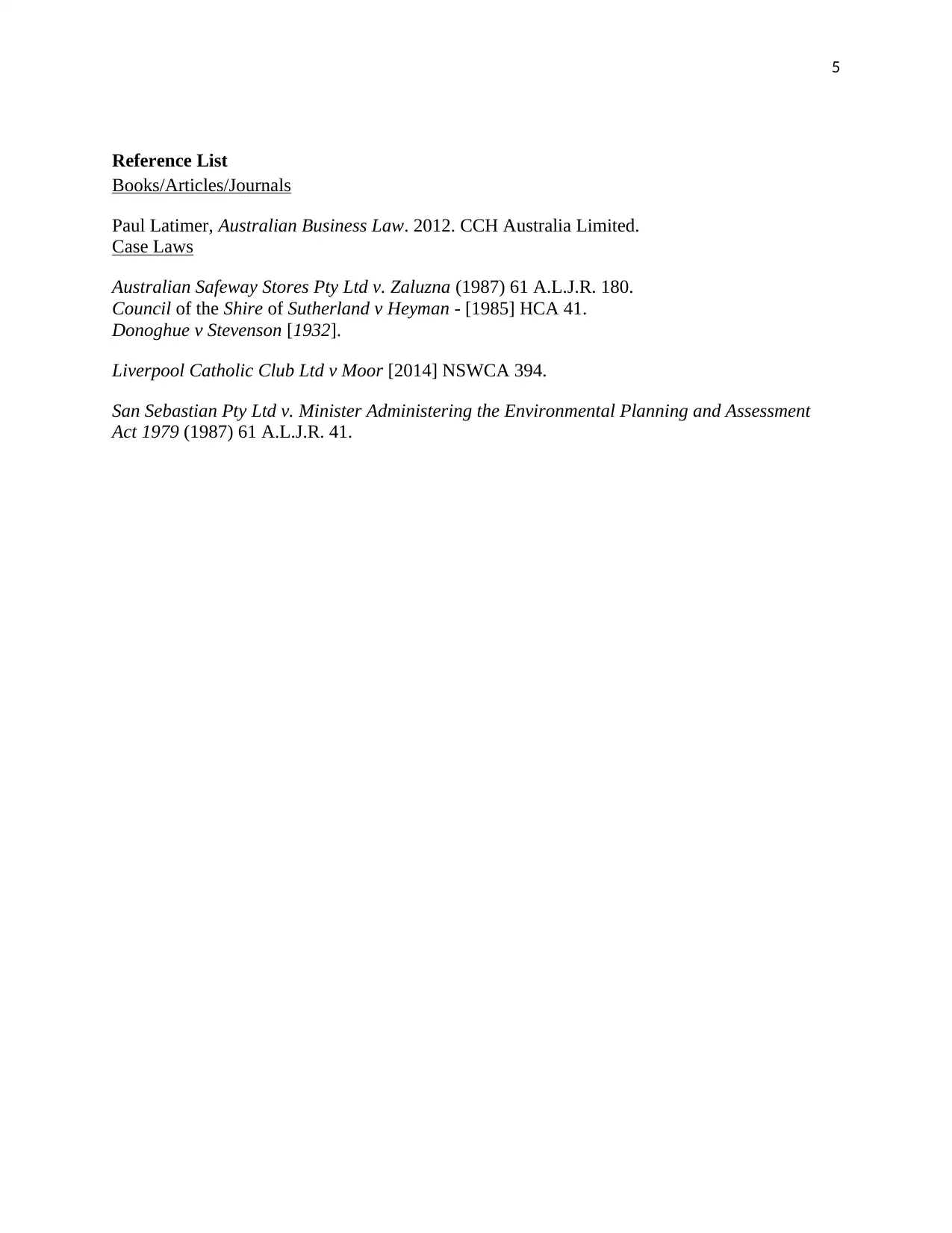
5
Reference List
Books/Articles/Journals
Paul Latimer, Australian Business Law. 2012. CCH Australia Limited.
Case Laws
Australian Safeway Stores Pty Ltd v. Zaluzna (1987) 61 A.L.J.R. 180.
Council of the Shire of Sutherland v Heyman - [1985] HCA 41.
Donoghue v Stevenson [1932].
Liverpool Catholic Club Ltd v Moor [2014] NSWCA 394.
San Sebastian Pty Ltd v. Minister Administering the Environmental Planning and Assessment
Act 1979 (1987) 61 A.L.J.R. 41.
Reference List
Books/Articles/Journals
Paul Latimer, Australian Business Law. 2012. CCH Australia Limited.
Case Laws
Australian Safeway Stores Pty Ltd v. Zaluzna (1987) 61 A.L.J.R. 180.
Council of the Shire of Sutherland v Heyman - [1985] HCA 41.
Donoghue v Stevenson [1932].
Liverpool Catholic Club Ltd v Moor [2014] NSWCA 394.
San Sebastian Pty Ltd v. Minister Administering the Environmental Planning and Assessment
Act 1979 (1987) 61 A.L.J.R. 41.
1 out of 5
Related Documents
Your All-in-One AI-Powered Toolkit for Academic Success.
+13062052269
info@desklib.com
Available 24*7 on WhatsApp / Email
![[object Object]](/_next/static/media/star-bottom.7253800d.svg)
Unlock your academic potential
Copyright © 2020–2025 A2Z Services. All Rights Reserved. Developed and managed by ZUCOL.




